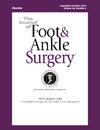舟状关节置换术(有辅助关节置换术和无辅助关节置换术)的疗效。
IF 1.3
4区 医学
Q2 Medicine
引用次数: 0
摘要
与其他内柱关节和/或后足融合术相比,脐带楔形(NC)关节成形术被认为是一种具有挑战性的手术。本研究的目的是:1)报告NC关节固定术后不愈合和并发症的发生率,无论是否采用辅助关节固定术;2)报告采用固定方法的发生率,并报告有多少楔形关节被融合。中西部地区的一家医疗机构对 2013 年 1 月 1 日至 2023 年 11 月期间的患者病历和 X 光片进行了回顾性审查。共纳入 137 例病例,其中 90 例(66%)发生了辅助关节关节置换术。总体非愈合率为 25%(34/137 例),总体翻修率为 15%(21/137 例)。使用辅助关节固定的不愈合率为 26%(23/90 例),未使用辅助关节固定的不愈合率为 23%(11/47 例)。单用螺钉固定的不愈合率最低,为20%(4/20例)。总体并发症发生率为 47%(65/137 例),最常见的原因是硬件问题(31%,43/137 例)。无论采用哪种固定结构,固定所有三个关节都会导致 18%(5/28 例)的不愈合。在固定内侧和中间楔形关节时,交叉螺钉和内侧钢板固定的不愈合率最高(24%,10/42 例),而螺钉和订书钉固定的不愈合率最低(11%,1/9 例)。总之,固定技术的选择和融合的楔形关节数量会影响数控关节固定术的成功率。实施正确的楔形关节融合术并认识到固定技术的局限性可能会降低发生骨不连和并发症的风险。本文章由计算机程序翻译,如有差异,请以英文原文为准。
Outcomes of naviculocuneiform arthrodesis with and without adjunct arthrodesis
Naviculocuneiform (NC) arthrodesis is considered a challenging procedure compared to arthrodesis of other medial column joints and/or hindfoot fusions. The objectives of this study were to 1) report the incidence of nonunion and complications after NC arthrodesis with or without adjunct joint arthrodesis, and 2) report incidences in which a fixation method was used and report how many cuneiform joints were fused. A retrospective review of medical charts and radiographs were performed on patients from 1/2013 through 11/2023 at a single institution in the Midwest region. 137 cases included and 90 (66%) adjunct joint arthrodesis incidents. The overall nonunion rate was 25% (34/137 cases) and overall revision rate was 15% (21/137 cases). The nonunion rate with adjunct joint arthrodesis was 26% (23/90 cases) and without was 23% (11/47 cases). The screws-alone fixation had the lowest nonunion rate of 20% (4/20 cases). The overall complication rate was 47% (65/137 cases), and the most common cause was hardware issues (31%, 43/137 cases). Fixating all three joints regardless of fixation constructs resulted in 18% (5/28 cases) nonunion. Crossed screws with medial plate fixation when fixated medial and middle cuneiform joints had the highest nonunion rates (24%, 10/42 cases) while fixation with screws and staples had the lowest nonunion rates (11%, 1/9 cases). In conclusion, the choice of fixation technique and number of cuneiform joints fused could affect the success of NC arthrodesis. Implementing proper cuneiform joints fusion and recognizing the limitations of fixation techniques potentially reduces the risk of nonunion and complications.
求助全文
通过发布文献求助,成功后即可免费获取论文全文。
去求助
来源期刊

Journal of Foot & Ankle Surgery
ORTHOPEDICS-SURGERY
CiteScore
2.30
自引率
7.70%
发文量
234
审稿时长
29.8 weeks
期刊介绍:
The Journal of Foot & Ankle Surgery is the leading source for original, clinically-focused articles on the surgical and medical management of the foot and ankle. Each bi-monthly, peer-reviewed issue addresses relevant topics to the profession, such as: adult reconstruction of the forefoot; adult reconstruction of the hindfoot and ankle; diabetes; medicine/rheumatology; pediatrics; research; sports medicine; trauma; and tumors.
 求助内容:
求助内容: 应助结果提醒方式:
应助结果提醒方式:


